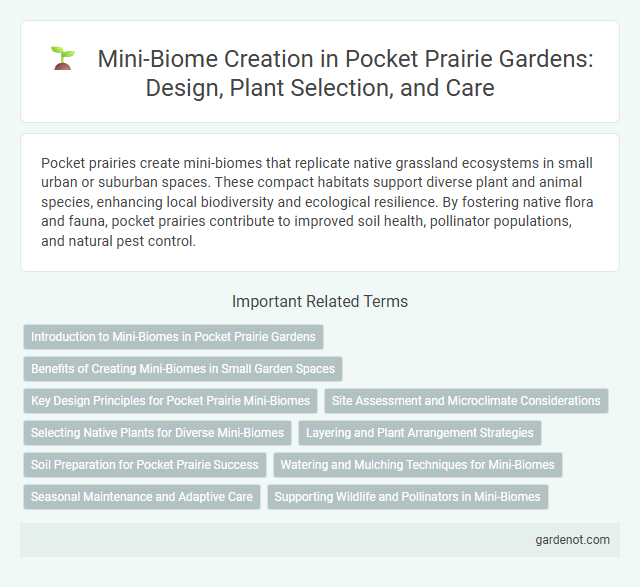Pocket prairies create mini-biomes that replicate native grassland ecosystems in small urban or suburban spaces. These compact habitats support diverse plant and animal species, enhancing local biodiversity and ecological resilience. By fostering native flora and fauna, pocket prairies contribute to improved soil health, pollinator populations, and natural pest control.
Introduction to Mini-Biomes in Pocket Prairie Gardens
Mini-biomes in Pocket Prairie Gardens serve as compact ecosystems that mimic natural prairie environments, promoting biodiversity and ecological balance. These small-scale habitats support native plants, pollinators, and soil organisms, fostering resilience and sustainability. Integrating mini-biomes enhances habitat connectivity and offers educational opportunities about prairie ecology.
Benefits of Creating Mini-Biomes in Small Garden Spaces
Creating mini-biomes in small garden spaces enhances biodiversity by providing habitats for a variety of native plants, insects, and wildlife, promoting ecological balance. These compact ecosystems improve soil quality and water retention, supporting sustainable gardening practices and reducing maintenance needs. Mini-biomes also offer educational opportunities to observe natural processes and foster environmental stewardship within limited areas.
Key Design Principles for Pocket Prairie Mini-Biomes
Pocket prairie mini-biomes emphasize native plant selection to maximize biodiversity and support local pollinators. Incorporating layered vegetation structures, including grasses, wildflowers, and shrubs, enhances habitat complexity and soil health. Strategic placement considers sunlight exposure and water drainage to optimize plant growth and ecological resilience.
Site Assessment and Microclimate Considerations
Site assessment for mini-biome creation in pocket prairies involves analyzing soil composition, moisture levels, and sunlight exposure to select optimal plant species that thrive locally. Understanding microclimate factors such as wind patterns, shade from nearby structures, and temperature variations ensures robust plant growth and biodiversity. Tailoring the mini-biome design to these environmental specifics enhances ecological resilience and supports native pollinators effectively.
Selecting Native Plants for Diverse Mini-Biomes
Selecting native plants for mini-biomes enhances biodiversity by supporting local ecosystems and promoting pollinator habitats. Incorporate a variety of species such as native grasses, wildflowers, and shrubs that thrive in specific soil and climate conditions of the pocket prairie. Emphasizing diversity ensures resilience, natural pest control, and sustainable growth within the mini-biome environment.
Layering and Plant Arrangement Strategies
Mini-biome creation in a pocket prairie relies on strategic layering and plant arrangement to maximize biodiversity and ecosystem function. Employing vertical layering with ground covers, mid-height forbs, and tall native grasses creates habitat niches while enhancing soil health and moisture retention. Thoughtful placement prioritizes native plant groupings that support pollinators, beneficial insects, and soil microbes, ensuring a self-sustaining and resilient mini-ecosystem.
Soil Preparation for Pocket Prairie Success
Soil preparation is crucial for establishing a thriving pocket prairie, involving the removal of invasive species and thorough tilling to aerate the soil and promote healthy root growth. Incorporating organic matter such as compost enhances soil fertility and moisture retention, creating an ideal environment for native prairie plants. Testing soil pH and nutrient levels guides amendments that optimize conditions for diverse plant species, ensuring long-term ecosystem stability and biodiversity.
Watering and Mulching Techniques for Mini-Biomes
Effective watering techniques for mini-biomes in pocket prairies involve using drip irrigation or soaker hoses to deliver consistent moisture directly to plant roots, minimizing water waste and promoting healthy growth. Mulching with organic materials such as straw, wood chips, or compost enhances soil moisture retention, suppresses weeds, and regulates soil temperature, crucial for the delicate balance of mini-biome ecosystems. Regular monitoring of soil moisture levels ensures optimal watering schedules, preventing overwatering or drought stress in these small-scale habitats.
Seasonal Maintenance and Adaptive Care
Pocket prairie mini-biomes require seasonal maintenance to ensure plant health and biodiversity, including scheduled pruning, removal of invasive species, and targeted watering during dry periods. Adaptive care strategies involve monitoring soil moisture and adjusting irrigation schedules to match precipitation patterns, as well as selecting native plants that thrive in local climate fluctuations. Regular assessment of plant vigor and pest presence guides timely interventions, promoting sustainability and ecological balance within the pocket prairie ecosystem.
Supporting Wildlife and Pollinators in Mini-Biomes
Mini-biomes in pocket prairies provide vital habitats for diverse wildlife and pollinators by incorporating native flowering plants, grasses, and sheltering microhabitats. These small-scale ecosystems enhance biodiversity, improve pollination rates, and support beneficial insects such as bees, butterflies, and ladybugs. Strategic plant selection and layered vegetation structures ensure year-round resources, fostering sustainable populations within urban and suburban landscapes.
Mini-biome creation Infographic

 gardenot.com
gardenot.com